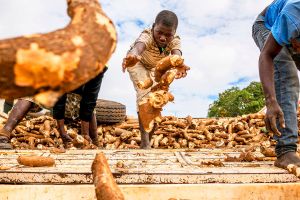The world today faces enormous challenges, including the threats of rapidly increasing instability, conflict, and migration as a result of inadequate food supplies and water scarcity.
Key Findings
America is facing enormous global challenges at the beginning of 2017, including the threat of rapidly increasing global instability, conflict, and migration as a result of inadequate global food supplies and water scarcity. Today’s global population of 7.4 billion people is expected to grow to 8 billion by 2024 and 10 billion by 2056. In addition, rising incomes in many low- and middle-income countries are further increasing the demand for food to satisfy the desire for higher quality, more nutritious, and diverse diets.
Yet we have never been as well equipped as we are today to respond to these challenges. Bipartisan leadership from the United States and action by the global community over the past 25 years has led to impressive results in the fight against the destabilizing forces of food insecurity. The US government, in close cooperation with the private sector and university system, is well-positioned to expand its legacy of commitment to food security and not only bolster the livelihoods of millions of smallholder farmers and entrepreneurs around the world, but also open up new business opportunities and partnerships in emerging economies.
Global food and nutrition security is in America’s national security and economic interests
Food security promotes national security.
Particularly in urban areas of low- and middle-income countries, high food prices and reduced access to food can trigger protests and rioting, including armed conflict, that lead to political and economic instability with global consequences. The global food crisis of 2007-08 demonstrated how spikes in food prices can plunge millions into hunger and deeper poverty, sparking riots that can undermine progress for years. The food price crisis hit hardest in countries with systems that were least able to respond effectively to global price volatility. For example, food price–related protests toppled governments in Haiti and Madagascar in 2007 and 2008. In 2010 and 2011 food prices and grievances related to food policy were one of the major drivers of the Arab Spring. Food insecurity can also be a powerful driver for migration. Despite ongoing conflicts, much of today’s global migration crisis is driven by economic factors, as millions of people flee hunger and poverty in their countries. On the other hand, countries that have achieved sustained development progress and greater food security are less susceptible to volatility and violence.
Food security promotes stability and economic opportunity.
Greater prosperity and economic growth in low-income countries create new and expanding markets, presenting growth opportunities for American farmers, ranchers, and businesses. For instance, in Africa alone the value of the agriculture and food sector is expected to reach $1 trillion by 2030. Rising incomes and changing diets are increasing demand for more diverse and nutritious foods. As economies grow, so does the demand for agricultural products, benefiting farmers locally and globally. Growing economic opportunities in the agriculture sector reach well beyond food production into sales of machinery and inputs, growth in demand for consumer packaged goods, and digital technologies for agriculture, where American companies are global leaders.
Agricultural development leads to greater food and nutrition security, economic growth, and well-being
If the history of development has taught us anything, it is that a strong agricultural sector is a cornerstone of inclusive and sustainable growth, broad-based development progress, and long-term stability. Simply put, sustainable growth, job creation, and stability in low- and middle-income countries is not possible without a robust and productive agricultural sector.
Agricultural development programs are cost-effective.
Investments in agricultural development have been proven to be more than twice as effective at reducing poverty as investments in other sectors. And gains to farmer productivity and income have proven enormously important both for the individuals involved and for societal progress more broadly.
Agricultural production has, on average, almost doubled in low- and middle-income countries since 1995.
Private investment in small and large farms and in agricultural value chains has been central to this growth, alongside public investments in infrastructure, R&D, and improvements in agricultural policies. There has been notable progress across almost all regions. These gains in agriculture are central to generating inclusive and sustainable growth, reducing hunger and poverty, improving nutrition, and achieving long-term stability.
The combination of greater food availability and higher incomes over the past two decades has led to substantial reductions in hunger and improved nutrition.
There are 200 million fewer chronically undernourished people in the world today compared with 1990, despite significant increases in population. The proportion of chronically undernourished people in low- and middle-income countries has fallen from 23 percent to 13 percent. At the same time, the number of people suffering from physical and cognitive stunting as a result of malnutrition has fallen from 250 million to 150 million.
Current challenges must be met
As important as the gains in fighting hunger and malnutrition over the past several decades have been, they are not nearly enough. Major obstacles for food and nutrition security loom large.
Population growth and rapid urbanization are increasing demand.
The global population will reach 8 billion by 2024 and 10 billion by 2056. Ninety-nine percent of the projected growth in the next century will occur in low- and middle-income countries.11 The challenges posed by this growth are daunting, especially in Africa, where more than half of the total population growth between now and 2050 will take place, adding another 1.3 billion people to the region. Most striking of all, in Nigeria, already the seventh-largest country in the world, the population is projected to grow from 180 million to nearly 400 million, surpassing the population of the United States by 2050. At the same time, many more people will live in cities than ever have before.12 The United Nations (UN) projects that the share of people living in urban areas worldwide will increase from about 50 percent today to two-thirds by 2050. Virtually all of the expected growth in world population between now and 2050 is expected to be concentrated in the urban areas of low- and middle-income countries.
Youth populations are exploding.
In much of Africa and South Asia, a large and increasing share of growing populations will be adolescents and young adults—known as a "youth bulge." Africa has the youngest population in the world. There are currently 200 million people in the region between the ages of 15 and 24, and this number is expected to double within the next 30 years.13 As young populations boom, their creativity and productivity can help boost their countries’ gross domestic product (GDP)—creating a pool from which the best and brightest can emerge to help solve problems around the world. Barred from participation in employment and opportunity, however, large populations of young people can be a destabilizing force in economies on the rise. A thriving food and agriculture sector, while by no means a silver bullet, is important to addressing the youth bulge by not only ensuring food and nutrition security, but also offering a source of employment throughout agricultural supply chains.
Risks from climate and natural resource pressures are increasing.
Nearly half of the planet’s land is currently used for agricultural and livestock production. As stewards of the land, farmers are among the most committed to preserving the natural resource base. Given that they depend on the land for their livelihood, they are also the most affected by a changing climate, including volatile weather and pressures on the natural resource base. Farmers must be valued as allies in preserving the environment. Indeed, among the most significant threats to food and nutrition security are the interrelated issues of climate change and natural resource constraints, including water scarcity, increased incidences of pests and disease, poor-quality soils, and volatile weather patterns.
Collaboration with our allies and partners is essential to ending hunger and malnutrition through accountability and opportunity
While it is crucial that the United States act to fight hunger and enhance global food security, it should not and will not act alone.
Government leadership is crucial for effective development.
Other governments, including rising global powers and low-income countries themselves, have all contributed significantly to improved global food security in recent years. The 2007-08 food price crisis was a wake-up call that spurred action not only by the United States, but by governments, multilateral institutions, businesses, investors, and civil society organizations around the world. Global leaders stepped up to meet the need for increased action and investment to advance global food security, agricultural production, and improvements in nutrition. Rising powers, especially China, India, and Brazil, have taken an increased interest in global agriculture and food systems, particularly in emerging markets. Moreover, governments in many low-income countries have significantly increased their own investments at home, improved their policy environments, and begun to strengthen many of the key institutions that provide the foundation for robust agricultural production and better nutrition. Continued action by all of these actors will be crucial for substantial and sustained progress in strengthening global food security.
Agriculture and food production are driven in large part by the private sector.
Up and down the value chain, from seed and tool companies to large and small farm producers to traders to food processors, the business of feeding the planet is stewarded by private investment. Achieving increases in agricultural productivity, improvements in nutrition, and enhanced global food security is only possible through the considerable capital, technological and product development capabilities, knowledge, experience, and distribution capacities of private businesses, large and small. Although private-sector investment in areas related to food security has increased rapidly in recent years, businesses still face many obstacles and impediments, keeping investment from reaching its full potential. Unlocking that potential is a key challenge, but one that brings enormous gains.
The United States must strengthen its commitment to ending hunger and malnutrition
Since World War II, when America’s leaders strove to meet the challenges of "hunger, poverty, desperation, and chaos" in the aftermath of such great conflict and suffering, the United States has been strongly committed to ending hunger and malnutrition around the world, not just as a moral imperative but as a matter of national security.15 Since that time, US efforts to advance global food and nutrition security have been among the greatest triumphs of American ingenuity and generosity.
In July 2016 Congress overwhelmingly passed the Global Food Security Act, authorizing the administration to continue to meet US global food and nutrition security goals. The act passed with strong bipartisan support, with no objections in the Senate and 87 percent approval in the House.
Recommendations
To address the challenges facing the United States and the world and threatening global food and nutrition security, the US administration together with Congress should support investments that take an integrated approach to agricultural-led economic growth, nutrition, and food system resilience through innovation and new technologies. To succeed, the administration and Congress must work closely with private businesses, farmers, entrepreneurs, investors, universities, research institutions, and civil society.
The crises and challenges facing the world and threatening food and nutrition security continue to call for action. To meet these challenges, we recommend that the administration and Congress take urgent action in four key areas.
Recommendation 1
Make global food and nutrition security a pillar of US diplomatic and national security engagement and strengthen the integration and coordination of activities both within the United States and around the world.
- Amplify the importance of global food security for US national security and diplomatic activities.
- Maximize resources through smart integration and coordination among agencies and between the US government and civil society.
- Work closely with bilateral and multilateral partners to achieve collective goals.
Recommendation 2
Prioritize public research investments to unlock innovation and harness new technologies for the agriculture, food, and nutrition sectors.
- Harness the unparalleled expertise of American universities and their research partners to solve the most pressing problems in agriculture, food, and nutrition at home and abroad.
- Expand support for the development of scientific and technological innovations that improve agricultural productivity, pest and disease resistance, supply chain development, and nutrition.
- Develop new technology platforms to collect more and better data and improve communication of information among key stakeholders.
Recommendation 3
Productively partner with committed companies to amplify the power of the private sector to transform food and nutrition security, from individual entrepreneurs to multinational businesses.
- Form strong public-private partnerships to harness the private sector’s strengths and spur inclusive and sustainable growth in smallholder agriculture and food systems in low-income countries.
- Strengthen and open the environment for investment, action, and collaboration.
- Increase access to finance and mitigate the risks that undermine opportunities for investors.
Recommendation 4
In strategic alignment with foreign policy goals, ensure that US agriculture and nutrition assistance programs are efficient and support low-income countries’ capacity to implement responsible and effective policies.
- Strengthen the effectiveness of development assistance through strong commitment to monitoring, learning, and evaluation for accountability.
- Build national governments’ capacity to prioritize, implement, manage, and measure their agricultural and nutrition policies, strategies, and goals.












